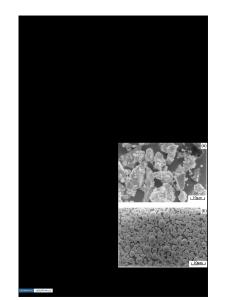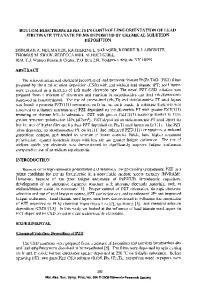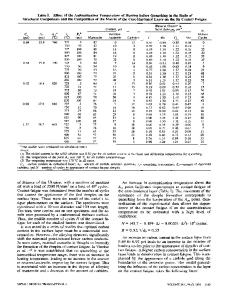The effect of RuO 2 /Pt hybrid bottom electrode structure on the leakage and fatigue properties of chemical solution der
- PDF / 452,526 Bytes
- 8 Pages / 612 x 792 pts (letter) Page_size
- 21 Downloads / 303 Views
MATERIALS RESEARCH
Welcome
Comments
Help
The effect of RuO2yPt hybrid bottom electrode structure on the leakage and fatigue properties of chemical solution derived Pb(Zrx Ti1–x )O3 thin films Seung-Hyun Kim, J. G. Hong, S. K. Streiffer, and Angus I. Kingon Department of Materials Science and Engineering, North Carolina State University, Raleigh, North Carolina 27695-7907 (Received 6 May 1998; accepted 13 August 1998)
We have investigated the effect of RuO2 (10, 30, 50 nm)yPt layered hybrid bottom electrode structure and film composition on the leakage and fatigue properties of chemical solution derived Pb(Zrx Ti12x )O3 (PZT) thin films. It was observed that the use of high Ti content (Zr : Ti 30 : 70) films with control of excess PbO at the thin RuO2 (10 nm)yPt bottom electrode surface reduced leakage current and showed good fatigue properties with high remanent polarization compared to the use of high Zr films (Zr : Ti 50 : 50) or thicker RuO2 (30, 50 nm)yPt bottom electrodes. Typical P-E hysteresis behavior of PZT films was observed even at an applied voltage of 3 V, demonstrating greatly improved remanence and coercivity. Fatigue and breakdown characteristics of these modified PZT thin films (Zr : Ti 30 : 70) on RuO2 (10 nm)yPt, measured at 5 V, showed stable behavior, and less than 15% fatigue degradation was observed up to 1010 cycles.
I. INTRODUCTION
Ferroelectric lead zirconate titanate (PZT) thin films are being developed for a variety of electronic applications, including nonvolatile memories and MEMS devices.1–3 The choice of electrode materials used for the PZT film has an impact on ferroelectric film quality and device performance; it is well known that the use of conductive oxide electrodes such as La12x Srx CoO3 or RuO2 helps improve the resistance to polarization fatigue for PZT.4 – 7 However, these electrodes have generally resulted in larger leakage currents and greater susceptibility to dielectric breakdown than noble metal electrodes. In order to improve upon some of these drawbacks, our group and other researchers have developed RuO2yPt layered hybrid bottom electrodes.8 –11 When using such hybrid electrodes, film properties are influenced by the thickness/partial coverage of the electrode layers. We have therefore fabricated PtyPZTyRuO2yPt heterostructures with different RuO2 thicknesses, using a new alkoxide-alkanolamine chemical solution deposition (CSD) method for the PZT. We will demonstrate the effect of the hybrid bottom electrode and a modified fabrication process on the microstructure, and therefore on the leakage and fatigue characteristics of the PZT thin films. II. EXPERIMENTAL PROCEDURE
The choice of starting materials and solvent is very important for producing good quality thin films using 1018
http://journals.cambridge.org
J. Mater. Res., Vol. 14, No. 3, Mar 1999
Downloaded: 17 Mar 2015
CSD. To investigate composition and orientation effects, two types of PZT solution (Zr : Ti 50 : 50, 30 : 70) were prepared using lead acetate trihydrate [Pb(OAc)2 ? 3H2 O], ti
Data Loading...











